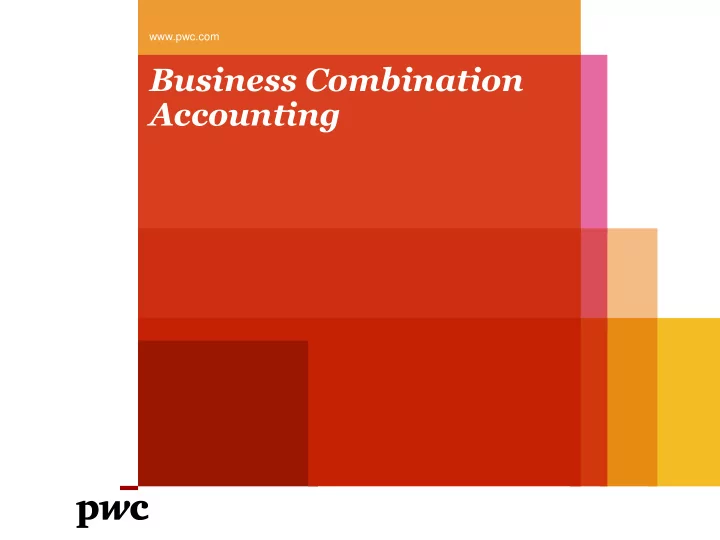

www.pwc.com Business Combination Accounting
Today’s Agenda Business Combination Accounting - Accounting Refresher - Pushdown Accounting PwC
Accounting Refresher
Not-for-profit entities – mergers and acquisitions Provides guidance for • - Combinations of two or more NPOs - NPO acquisitions of for-profit organizations - Noncontrolling interests (minority interests) - Goodwill - Intangible assets Codified in ASC 958-805 • PwC
Does FAS 164 apply to my transaction? Yes No • Acquisition of an NPO • Joint venture • Acquisition of a for-profit by an NPO • Reorganization of entities under common control • Acquisition of department, division, or other portion of • Acquisition of a group of assets an entity – when meets FAS 141(R) “definition of a business” • Merger (complete ceding of control to form a new • Acquisition made by any for-profit entity entity) PwC
Merger vs. Acquisition Is my transaction a merger or an acquisition? • Merger • Two (or more) entities cede control to new economic entity. None of the combining organizations controls the new entity; a brand-new economic entity has been created • Acquisition • One entity obtains control over another PwC
Indicators to consider Indicators for a merger Indicators for an acquisition No one party can dominate the negotiations One party dominates the process and/or and process leading to formation of dictates the terms of the transaction combined entity Combining entities cease to exist as One organization continues on as the autonomous entities surviving corporation Neither entity dominates the day to day One entity appoints significantly more of management or governance the governing board One entity retains significantly more of its key officers New articles, bylaws, operating policies, One party retains its bylaws, operating and practices are created policies, and practices substantially unchanged PwC
Merger Accounting If transaction is determined to be a merger • Assets & liabilities brought forward at book values on merger date (not as of beginning of the period) • Combined activity is reported from merger date forward • Conform accounting policies PwC
Hospital A mergers with Hospital B creating Hospital C As of the Merger Date Hospital A Hospital B Conforming Hospital C Adjustments Carrying Carrying value value Assets 500,000 Assets 600,000 50,000 1,050,000 Liabilities 250,000 Liabilities 350,000 (25,000) 575,000 Net assets 250,000 Net assets 250,000 475,000 PwC
Acquisition accounting – general rule 5 step process 1. Inventory all assets acquired and liabilities assumed 2. Determine FV of each asset and liability as of the acquisition date 3. Aggregate FVs of all assets and liabilities 4. If FV assets > FV of liabilities + consideration, recognize inherent contribution (income) 5. If FV liabilities + consideration > FV of assets, recognize goodwill or contribution expense, as appropriate (depends on whether acquiree predominantly contribution supported) PwC
Determining fair value of assets and liabilities Item Considerations – Acquisition Date Current assets CV generally approximates fair value ASC 958-320 (FAS 124) Carried at FV investments Alternative investments -- FV (FV Carried at FV option ) Alternative investments – equity Equity method may approximate fair value method Alternative investments – cost FV must be determined (establish new “cost basis”) Pledges/split-interest FV must be determined agreements AICPA white paper issued November 2012 might be helpful PwC
Determining fair value of assets and liabilities Item Considerations PP&E FV must be determined (e.g., through appraisal) Intangible assets FV must be determined (typically using “income approach”) Current liabilities CV generally approximates fair value Unfunded pension Remains at CV – not fair valued obligations Tax-exempt debt Consider type of debt: VRDOs - FV Fixed or auction rate – FV must be determined Tip: See EMMA for recent trade data, but consider ASC 820-10 (Fair Value Measurement and Disclosure) and ASU 2009-05 Contingencies Special considerations may apply to measuring contingent liabilities PwC
Hospital A acquires Hospital B Hospital B as of the Acquisition Date Assets Liabilities & Net Assets Carrying Fair value Carrying Fair value value value Cash 36,000 36,000 Payables 51,000 51,000 PPE 182,000 250,000 Bank loans 115,000 115,000 and other Intangibles -- 2,000 Other 265,000 265,000 Other assets 443,000 443,000 URNA 224,000 TRNA/ 6,000 PRNA Total 661,000 Total 661,000 PwC
Hospital A’s Journal Entry Debit Credit Cash 36,000 PPE 250,000 Intangible assets 2,000 Other assets 443,000 Payables 51,000 Debt (non-bonds) 115,000 Other liabilities 265,000 TRNA/PRNA contribution 6,000 revenue Subtotals 731,000 437,000 UR contribution revenue * 294,000 * Reported within Hospital A’s performance indicator PwC
Intangible asset considerations Consider the value of commonly Note the following: identified intangible assets as part of a business combination • Assembled workforce transaction: does not meet the definition of identifiable Trade names intangible. Patient records • Unlike acquired Certificates of need customer relationships, Non-compete agreements acquired donor relationships are not recognized separately-- subsumed into goodwill. PwC
Pushdown Accounting
Pushdown accounting What you need to know Addresses the scope and threshold for applying • Pushdown accounting optional upon a pushdown accounting in a change in control subsidiary’s financial • No circumstances would require or preclude statements. pushdown accounting Prospective to new transactions or • retrospective to previous transactions if there is a change in control • Each change-in-control event considered Provides guidance for separately (not an accounting policy), but public entities, private election is irrevocable once pushdown companies, and not- accounting is elected for-profits. On the Coming Recently horizon soon issued
Pushdown accounting Application Considerations • The application of pushdown accounting represents the termination of the old accounting entity and the creation of a new one • Step-up basis of assets and liabilities reported • Predecessor / successor considerations in acquiree’s stand alone financial statements • Standalone statements should mirror consolidating statement presentation • Acquiree’s information should not include the contribution revenue recorded from the acquisition Sample items to consider when electing pushdown accounting • • Needs and uses of the acquiree’s financial statements • Future record keeping (ie one or two sets of “books” )
Questions
Recommend
More recommend